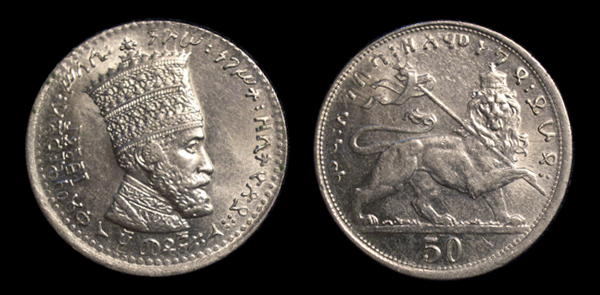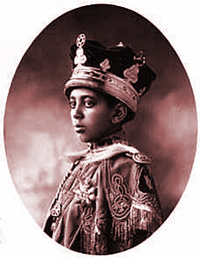
50 MATONAS COIN - ETHIOPIA - EMPEROR HAILE SELASSIE I
(KM 31)
Date: A.D. 1923
Obverse: Portrait crowned head right - KING OF KINGS OF ETHIOPIA
Reverse: Crowned lion right, right foreleg raised holding ribboned flag - CONQUERING LION OF THE TRIBE OF JUDAH
|
The Emperor Haile Selassie I was Born Tafari Makonnen on July 23, 1892 in the village of Ejersa Goro, in the Harar province of Ethiopia during the reign of the emperor Menelek II. His father was Ras Makonnen Woldemikael Gudessa, the governor of Harar, and his mother was Yeshimebet Ali Abajifar. He inherited his imperial blood through his paternal grandmother, Princess Tenagnework Sahle Selassie, who was an aunt of Emperor Menelik II who claimed to be a direct descendant of Makeda, the queen of Sheba, and King Solomon of ancient Israel. Tafari Makonnen rose to the governorship of Harar during a time of political turmoil and played a minor role in the progressive movement led by Fitawrari Habte Giorgis Dinagde, war minister to Menelik II. This movement deposed the emperor Lij Iyasu in 1916 over his conversion to Islam and what was perceived as generally disrespectful and scandalous behavior. This led to the rise of the former emperor Menelik's daughter Zewditu. Tafari Makonnen was elevated to the rank of Ras and made heir apparent. In the power arrangement that followed, Tafari accepted the role of Regent and became the de facto ruler of the Ethiopian Empire. As regent, the new Crown Prince was a proponent of modernization, oversaw Ethiopia's admission to the League of Nations in 1923, and abolished slavery in 1924. He also toured Europe where he observed modern European society which made a big impression on the young prince. Empress Zewditu crowned him as King in 1928, under pressure from the progressive party. The crowning was very controversial as he occupied the same immediate territory as the Empress (a unique situation that had never happened before) causing conflict, insult, and eventually rebellion by the supporters of the Empress lead by her husband Ras Gugsa Wele. Wele marched towards Addis Ababa but was defeated and killed at the Battle of Anchiem in 1930. Soon after the Empress died suddenly and although it was long rumored that the Empress was poisoned, it has since been documented that the Empress had succumbed to an intense flu-like fever and complications from diabetes. upon the death of the Empress Zewditu, Tafari Makonnen was made Emperor and proclaimed King of Kings of Ethiopia on November 2 1930. His full title being "His Imperial Majesty Haile Selassie I, Conquering Lion of the Tribe of Judah, King of Kings and Elect of God". The Emperor introduced Ethiopia's first written constitution in 1931 which made provisions for an appointed bicameral legislature. It was the first time that non-noble subjects had any role in official government policy. The constitution also limited the succession to the throne to the descendants of Emperor Haile Selassie -- a detail that caused considerable unhappiness with other dynastic princes, such as the princes of Tigrai, and even his loyal cousin Ras Kassa Hailu. Following the 1936 Italian invasion of Ethiopia from its colonies in Eritrea and Somalia, Emperor Haile Selassie I made an attempt at fighting back the invaders personally. He joined the northern front by setting up headquarters at Desse in Wollo province. The Italians had the advantage of larger numbers and more advanced weapons, including a large airforce. The Emperor made a stand against the Italians at Maychew in southern Tigray. His army, some using antiquated rifles and even spears, was defeated and retreated in disarray. He found himself being attacked by rebellious Raya and Azebu tribesmen as well. The council of state agreed that because the capitol of Addis Ababa could not be defended, the government would relocate to the southern town of Gore. They decided, in the interests of preserving the Imperial house, the Emperor and the Imperial family should leave immediately by train for Djibouti and from there to Jerusalem where he would endeavor to present the case of Ethiopia to the League of Nations at Geneva. This did not sit well with some to see a monarch flee his nation in its time of peril and would permanently tarnish his reputation for some. The Emperor appointed his cousin Ras Imru Haile Selassie as Prince Regent in his absence. Marshal Pietro Badoglio led the Italian troops into Addis Ababa and Mussolini declared King Victor Emanuel III the new Emperor of Ethiopia and Ethiopia an Italian province. Badoglio, declared the first Viceroy of Ethiopia and "Duke of Addis Ababa", returned to Rome and took with him Haile Selassie's throne as a "war trophy", using it as a couch for his dog. The Emperor pleaded for help from the League of Nations. He detailed the death and destruction rained down upon his people and he reminded the League that "God and History would remember their judgment." He asked "What answer am I to take back to my people?" His eloquent address was moving and turned him into an instant world celebrity. He became Time Magazine's "Man of the Year" and an icon for anti-Fascists around the world. He failed, however, in getting what he needed to help his people fight the invasion. The League agreed to only partial and ineffective sanctions on Italy, and several members even recognized the Italian conquest. Emperor Haile Selassie I spent his five years of exile (1936–1941) mainly in the United Kingdom. During this period, His two sons-in-law, Ras Desta Damtew and Dejazmach Beyene Merid, were executed by the Italians. His daughter Princess Romanework, along with her children, was taken in captivity to Italy where she died in 1941. His grandson, Lij Amha Desta, died in Britain just before the restoration and his daughter, Princess Tsehai, died shortly after. Haile Selassie I returned to Ethiopia in 1941, after Italy's defeat in Ethiopia by the United Kingdom and Ethiopian patriot forces. Between 1948 and 1956, Haile Selassie revised the constitution broadening the power of the elected leaders, pushed for modern educational methods, and furthered his plans for modernization in other areas showing himself to be generally temperate and prone to compromise for the greater good. In an attempt to improve relations between the state and ethnic groups, he granted autonomy to Afar lands that were difficult to control and looked to institute social reform. His reforms to end feudalism were slow and weakened by the compromises he made with the entrenched aristocracy. This would be a key factor in the downfall of his regime. In 1960, while the emperor was on a state visit to Brazil, his Imperial Guard staged an unsuccessful coup attempt, briefly proclaiming his eldest son Asfa Wossen as the new Emperor who was forced to accept. The coup d'etat was crushed by the regular Army and police forces loyal to the emperor but the coup attempt marked the beginning of an increased radicalization of Ethiopia's growing number of younger intellectuals. In 1962, he placed Eritrea under the Ethiopian Constitution. He had already governed the former Italian colony since 1950 by mandate under a separate Constitution that had been written by the UN. This act of complete Union aggravated a struggle with the Eritrean independence movement that would continue long past his reign and conflict between Ethiopia and Eritrea still continue to this day and has been a major cause of instability in that region. The increasingly radical student movement as well as Marxism took hold in the late 60s and early 70s. Although the emperor agreed to land grants and poverty alleviating measures, they were opposed and unpopular with the royal class causing further conflict and unrest. A devastating drought in the Province of Wollo in 1972 –73 caused a large famine which was covered up by local officials and kept from Haile Selassie I who was celebrating his 80th birthday amidst much pomp and ceremony. When a BBC documentary exposed the existence and scope of the famine, the government was seriously undermined and the Emperor's once unassailable personal popularity fell. Simultaneously, economic hardship and widespread military mutinies in the country further weakened him. The Derg, a committee of low ranking military officers and enlisted men, took advantage of the government's disarray to depose Emperor Haile Selassie I in 1974. He and his family were placed under house arrest and then imprisoned. In 1975 Haile Selassie I died following complications from a prostate operation, though is doctor denied that complications had occurred and believe that he was suffocated in his sleep. Witnesses came forward after the fall of the Marxist government in 1991 to reveal that the Emperor's remains had been buried beneath the president's personal office. In 2000 Emperor Haile Selassie I was given an Imperial funeral by the Ethiopian Orthodox church. With his wife, the Empress Menen, the Emperor had six children: Princess Tenagnework, Crown Prince Asfaw Wossen, Princess Tsehai, Princess Zenebework, Prince Makonnen and Prince Sahle Selassie. He was succeeded by his son Emperor Amha Selassie (Asfaw Wossen Taffari) who had been proclaimed emperor, and accepted (under duress), in the earlier unsuccessful coup against his father. He was again proclaimed emperor by the Revolutionary Derg (again, under duress) until the monarchy was finally abolished. He went into exile where he was proclaimed (but never crowned) emperor in exile Interesting Note: Haile Selassie I is possibly best known as God incarnate among followers of the Rastafari movement which emerged in Jamaica during the 1930s under the influence of Marcus Garvey's "Back to Africa" movement, and as the Black Messiah who will lead the peoples of Africa and the African diaspora to freedom. His traditional lineage from Solomon and Sheba are seen to be confirmation of the titles of the returned Messiah in the prophetic Book of Revelation in the New Testament: Selassie's own spiritual teachings permeate the philosophy of the movement. Haile Selassie I had no role in organizing or promoting the Rastafari movement. For many Rastas, this is seen as proof of his divinity in that he was no false prophet claiming to be God in order to enjoy the benefits of being a cult leader. He was a devout member of the Ethiopian Orthodox Church, as demanded by his political role in Ethiopia, and it was to his role as Emperor of Ethiopia that he devoted his life. His publicly known views towards the Rastafarians varied from sympathy to polite interest. During the Emperor's visit to Jamaica, he told the Rastafari community leaders that they should not emigrate to Ethiopia until they had liberated the people of Jamaica but In order to help the Rastas and their aspirations of returning to Africa, the Emperor donated a piece of land at Shashamane, 250 km south of Addis Ababa, for the use of Jamaican Rastafarians. There is a Rastafarian community there to this day. He is a central theme and presence within the life of Rastafarians. The Rastafarians use his full name, Haile Selassie I, pronouncing the Roman numeral that indicates "the first" as the word "I", he is also called "Jah Rastafari Selassie I," and affectionately "Jah Jah" |



